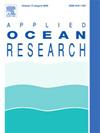极地海洋冻土中嵌入式地基极限承载力的热力学序列耦合分析
IF 4.3
2区 工程技术
Q1 ENGINEERING, OCEAN
引用次数: 0
摘要
本研究介绍了数值模拟分析的结果,旨在研究在不同的埋深比 H/D(H/D = 1/3、2/3 和 1 或 H/D = 10/3、5 和 20/3)和强度折减系数 su,T/su0 (su,T/su0 = 0.1、0.5)条件下,温度对三种地基(即通用铲形地基 (SGEN)、裙式地基和桩基)垂直极限承载力的影响。通过小应变有限元分析 (FEA) 研究了潜热对地基承载力的影响。本次调查和之前的研究结果表明,地基的竖向极限承载力随时间的推移而减小,但随着地基嵌固率的增大而增大。对于地基而言,强度折减系数对竖向极限承载力起着重要作用。值得注意的是,当强度折减系数从 0.5 降到 0.1 时,竖向极限承载力的折减率会相应增加 3 到 6 倍。因此,提出了归一化承载力系数模型,为冻土地区的工程设计提供了优化工具。本文章由计算机程序翻译,如有差异,请以英文原文为准。
Thermal-mechanical sequence coupling analysis on the ultimate bearing capacity of embedded foundations in polar marine permafrost
This study presents the results of the numerical simulation analysis, aiming to investigate the temperature effects on the vertical ultimate bearing capacity of the three types of foundations, namely generic spudcan (SGEN), skirted and pile foundations, at different embedded depth ratios H/D (H/D = 1/3, 2/3, and 1 or H/D = 10/3, 5, and 20/3) and strength reduction coefficients su,T/su0 (su,T/su0 = 0.1, 0.5). The latent heat effects on foundation bearing capacities are studied by small strain finite element analysis (FEA). The findings from this investigation and previous research indicate that the foundations' vertical ultimate bearing capacity decreases with time, while it increases with increasing the foundation's embedment ratio. For the foundations, the strength reduction coefficient plays an important role in the vertical ultimate bearing capacity. Notably, as the strength reduction coefficient decreases from 0.5 to 0.1, the reduction rate of the vertical ultimate bearing capacity increases by ∼ 3 to 6 times accordingly. Consequently, a normalized bearing capacity coefficient model has been proposed to provide an optimization tool for engineering design in permafrost regions.
求助全文
通过发布文献求助,成功后即可免费获取论文全文。
去求助
来源期刊

Applied Ocean Research
地学-工程:大洋
CiteScore
8.70
自引率
7.00%
发文量
316
审稿时长
59 days
期刊介绍:
The aim of Applied Ocean Research is to encourage the submission of papers that advance the state of knowledge in a range of topics relevant to ocean engineering.
 求助内容:
求助内容: 应助结果提醒方式:
应助结果提醒方式:


